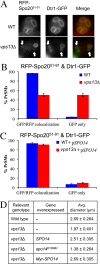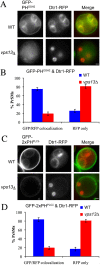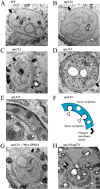VPS13 regulates membrane morphogenesis during sporulation in Saccharomyces cerevisiae
- PMID: 22442115
- PMCID: PMC3434806
- DOI: 10.1242/jcs.105114
VPS13 regulates membrane morphogenesis during sporulation in Saccharomyces cerevisiae
Abstract
The hereditary disorders chorea acanthocytosis and Cohen syndrome are caused by mutations in different members of a family of genes that are orthologs of yeast VPS13. In vegetatively growing yeast, VPS13 is involved in the delivery of proteins to the vacuole. During sporulation, VPS13 is important for formation of the prospore membrane that encapsulates the daughter nuclei to give rise to spores. We report that VPS13 is required for multiple aspects of prospore membrane morphogenesis. VPS13 (1) promotes expansion of the prospore membrane through regulation of phosphatidylinositol phosphates, which in turn activate the phospholipase D, Spo14; (2) is required for a late step in cytokinesis that gives rise to spores; and (3) regulates a membrane-bending activity that generates intralumenal vesicles. These results demonstrate that Vps13 plays a broader role in membrane biology than previously known, which could have important implications for the functions of VPS13 orthologs in humans.
Figures






